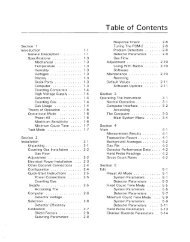PM-7 Operating Manua.. - Voss Associates
PM-7 Operating Manua.. - Voss Associates
PM-7 Operating Manua.. - Voss Associates
You also want an ePaper? Increase the reach of your titles
YUMPU automatically turns print PDFs into web optimized ePapers that Google loves.
Algorithms<br />
Statistical Theory<br />
To use the model for radiological measurements, the average number of<br />
counts expected during a single measurement cycle must be known with<br />
reasonable accuracy. Applying this to background, we would call the<br />
expected number of counts N B(avg) since the measured background average<br />
is the best information available for predicting how many counts will<br />
occur. Another statistical parameter of importance is the standard deviation<br />
or, sigma, of N B(avg) which is defined as the square root of NB(avg). Any<br />
background count, N C , can be scaled to the normal distribution function by<br />
determining how many sigmas N C is away from N B(avg) . The calculation is<br />
shown below. The multiplier of “sigma” will be called SIGMA FACTOR or<br />
“SF”.<br />
–<br />
–<br />
SF<br />
N C<br />
N B( avg)<br />
= -------------------------<br />
sigma<br />
N C<br />
N B<br />
= ----------------- Eq. 2.5<br />
N B( avg)<br />
Because the distribution function is well defined for “x”, the identity of Eq.<br />
2.5 defines the predicted distribution function for background counts.<br />
Suppose that we are interested in finding a number of counts, "N c ", that we<br />
would alarm on in a detector channel such that background alone would<br />
cause an alarm no more than 1 time in 10,000 measurements.<br />
That corresponds to a cumulative distribution of “x” of 0.9999 --<br />
background is expected to be less than “x” 9,999 times in 10,000<br />
measurements for a false alarm rate of 0.0001. Tabulated values for F(x) are<br />
listed in Table 4-1, “Probability Distribution Table”. In this example, F(x) =<br />
0.9999 is known. Entering the table we find that the closest value to 0.9999<br />
corresponds to x=3.72. The alarm set point must then be 3.72 times “sigma”<br />
above N B(avg) . The false alarm rate is determined by SF if the number of<br />
counts above background to alarm on, N A , is determined by Eq. 2.6:<br />
N A<br />
R B<br />
= SF ----- Eq. 2.6<br />
T<br />
Note The false alarm rate of a single detector channel is not equal to the overall<br />
false alarm rate of the portal. As implied by the foregoing, the false alarm rate for<br />
a single channel is equal to 1 - F(SF). For a monitor with “N” independent<br />
channels and the same SF for each channel, the overall probability of false alarm<br />
is equal to 1 - [F(SF)] N . The <strong>PM</strong>-7 has seven independent channels determined<br />
by the six detectors and the sum channel. If different SF's are utilized, the overall<br />
probability of false alarm for “N” channels is equal to<br />
1 - [F(SF) 1 x F(SF) 2 x . . . x F(SF) N ]. ▲<br />
Thermo Fisher Scientific<br />
Personnel Monitor -7 Techical Guide_4-3_













